This morning I watched as a masked and gloved demo crew emptied an apartment in the building across the street. Shitty traditional furniture from decades, not centuries, ago; an emptied bookcase; a disgusting-looking twin mattress; a couple of large garbage cans full of stuff small enough to stuff in a garbage can.
All the kind of stuff left behind by someone who died old, and thrown away like the stuff of someone who died alone.
When I finally realized they were done, I thought I ought to take a picture, not enough time to open the screen on the window.
The autofocus on my phonecam caught the grid and created an unexpectedly beautiful pixellated effect, which I thought was nice. Dying alone and having your entire life summarily tossed into a landfill, not so much.
Author: greg
Finite Jest
Holy crap, David Foster Wallace died Friday night. [1] I thought we had a deal [2] we were going to grow old together…. dammit
[1] hanged.
[2] the deal: he writes, I read.
Madness, Madness
On the occasion of a Film Forum series of his work, Terrence Rafferty has an interesting, if brief and kind of depressing think about David Lean’s method in the NY Times.
Maybe the series can wrest Lean away from the clutches of the cinematic cliche crowd that always puts Lawrence of Arabia in their award show montages. He’s kind of like the Dalai Lama; a no doubt great god who attracts the most annoying sort of sycophantic groupies. [Or is that Tarantino?]
Bonus: block out Katherine Hepburn’s schtick and just treat Summertime as a fantastic documentary of 1950’s Venice. Also, the movie was blurbed by the film critic of the Daily Worker. !
Related: David Ehrenstein’s relook at Lean in Artforum makes me feel a little guilty.
Met Throws Lot In With Curator
I really didn’t follow the Metropolitan Museum’s horse race to see who would replace Philippe de Montebello as director, but I find myself caring deeply that it’s tapestry curator Thomas Campbell.
Campbell’s two shows on Renaissance and Baroque tapestries in 2002 and 2007 respectively, were some of the most unexpectedly spectacular and intelligent exhibitions I’ve ever seen. The Renaissance show was quite moving, even, which still surprises me.
So given all the possible museum world follies that could have befallen the selection, it feels very heartening that the museum has chosen someone with curatorial depth and scholarship, who’s able to make highly relevant cases for even seemingly secondary arts, and to put on truly beautiful, important shows.
Some Days You’re The Alaskan Cyclist, And Some Days You’re The Porcupine
I’m not sure, but I think the references to porcupines and garage doors in this editorial in the Anchorage Daily News is some kind of GOP code.
Keep right, quills
I’ve never seen a porcupine sprint.
The other night I almost hit one while riding a bicycle home. Waddle and roll, old quills was in a hurry on the right side of the trail just shy of the overpass that leads to the landfill outside of Eagle River. Headlamp light caught his tail a few feet before my front tire would have. I swerved. Quills kept going in a straight line.
No dash to the safety of brush and shadow. Just straight on, huff and puff and still slo-mo.
I had a vision of a leg full of quills if I’d hit the critter and fallen on it. Having pulled quills from the swollen muzzles of yelping dogs, I’ve got no desire to feel their pain.
Quills can kill, but the porcupine never seems to mean any harm.
Good thing they’re nocturnal. They don’t move fast enough for daylight living.
“Death on dogs,” is how an acquaintance once described them. He recommended shooting them. Another old Alaskan once told me they were walking wilderness survival kits. Easy to kill with a stick. Fresh meat.
Deal death to a porcupine? Its very nature rules out fair chase. I once watched one go up a birch tree to escape a dog. The leaves grew faster than the porcupine climbed. Fortunately for both dog and porcupine, it was already out of the dog’s range by the time the dog saw it.
Another time a porcupine huddled, head tucked between front paws against a garage door as I walked up to it in the dark. It raised its head once and looked back to see if I was still there, then put its head back down. It seemed to be thinking that if it didn’t see me, I wouldn’t be there anymore.
So I left. I waited half an hour before checking to see that it was gone. I figured the porcupine needed at least that much time to get away.
— Frank Gerjevic
Well, I Remember The First Time I Visited The Spiral Jetty
Former NGA curator and Dia director Jeffrey Weiss writes about the state of Land Art in the latest issue of Artforum. His focus: T.S.O.Y.W., a 3-hour Earthworks road trip movie/installation by Amy Granat and Drew Heitzler shown in this year’s Whitney Biennial, and the Sculpture Center’s recent exhibition of feminism and Land Art in the 1970’s [which featured the Agnes Denes work, Wheatfield – A Confrontation in Battery Park City that I mentioned a couple of months ago.]
As Earthworks come of age, their fate has begun to look contingent and fragile. Those who are charged with caring for the sites are rightly doing what they can to forestall change; but a true poetics of Land art–given the very nature of the medium–must at least contend with the conflict between an ethic of preservation and the entropic pull of nature and culture that belongs to the content of the work. In this setting, Granat and Heitzler are melancholic visionaries. Their wheels, like reels, turn in order to draw a straight line and follow it: Their line is the road, a figure for unbounded space and inexhaustible time. But as their bike moves forward, their eyes gaze, historically, back; T.S.O.Y.W. shows us that memory has become a chief element of the temporal condition of the Earthwork. The film’s end is a running-down and out, a sudden shift from images of the infinite desert to scarred film leader, then, abruptly, to nothing at all. Forever turns out to be the ultimate conceit. [emphasis added]
Hmm, let’s ignore the conceit of a film ending abruptly while it’s actually screening on an endless loop in a gallery.
I’m intrigued by the idea that memory is a “chief element” of Land Art and its “temporal condition,” if it somehow equates to the divergence between the contemporary condition and experience of visiting the work/site and its various representations, whether in film, photograph, or documenting ephemera.
For most art audience members over the intervening decades–curators, critics, collectors and artists included– Land Art exists as books, photos, gallery presentations, and texts. At the Whitney’s Robert Smithson retrospective in 2005, one symposium panelist went so far as to argue that Spiral Jetty was primarily a film and photo work, as if the jetty itself were just a location, a bit of IMDb trivia. It sounded to me then like just the kind of critical reading that a New York art worlder would make who’d come of age when the Jetty was submerged, and who’d never bothered going to Utah in the 10+ years since it re-appeared.
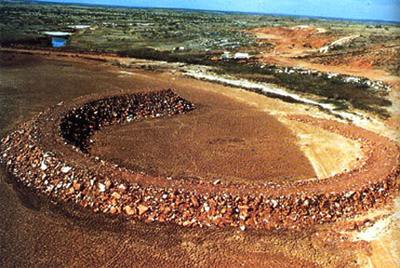
With images and expectations formed in our head, actually visiting an Earthwork can be as disorienting as meeting your favorite NPR host. Or if, as Weiss points out, the work has deteriorated over time, it’s like meeting an author who hasn’t updated his bookjacket photo for a while. And the disconnect can be jarring; When Titus O’Brien made his pilgrimage to Smithson’s last work, Amarillo Ramp, he found the powerful sculptural form of the iconic 1973 photograph had become “a worn down, weed covered, neglected berm of dirt you’d just mistake for an old watering trough dam. A phantom.”
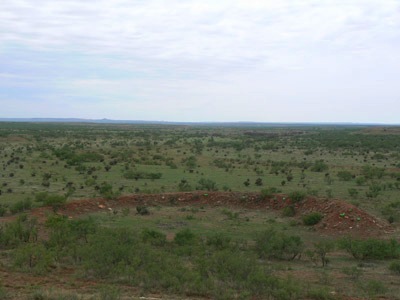
But memory is more than the gap between reality and what we think reality is; it’s the reconciliation and construction of the two. Weiss’s concerns about the complications Land Art curators face is right, but maybe not in the way he says. From Marfa to the Lightning Field to the Jetty to even Michael Heizer’s Double Negative and Turrell’s Roden Crater, the Earthworks Road Trip has matured in the last decade as both a real experience and a concept. As more people make the pilgrimages and have personal encounters with these works, not only do their memories of the works change, but other people begin to perceive the works not just as images in a book or on a wall, but as visitable sites.
I wonder how the perceptions and understanding of Walter deMaria’s Lightning Field change when they’re based, not just on John Cliett’s dramatic, official photos [via], but on firsthand accounts of the 24-hour visiting experience, very few of which appear to involve actual lightning? And how would that change if Dia and deMaria allowed visitor photographs? When it comes to Land Art in the present and future, there are still a few more conceits left to be addressed.
Why I FFFFFing Hate FFFFound
I’m sorry, but I think the deracinated, uncredited, untraceable image orgy Ffffound to be the nadir of the eye candy, surface-uber-alles design world. And the people at Things offer my contempt a half-full glass of niceness:
We’ve always known that the object in isolation is not as fascinating as the object within its cultural context. The internet provided not just a new context, but a new way of looking at existing contexts. It took a while to realise it, but the collection, presentation, and curation of objects has become an intrinsically revealing way of tracing the ins and outs of modern culture.
A School Called Hope
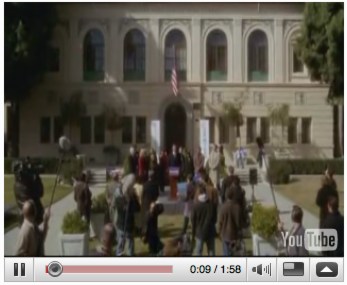
“This is the place that matters.” And this just gets better and better. Walter Reed Middle School served as the backdrop for the presidential candidacy of Democratic congressman Matt Santos–as played by Jimmy Smits on West Wing.
West Wing producer-writer Eli Attie told the Guardian in February that the Santos character was based on Barack Obama:
“I drew inspiration from him in drawing this character,” West Wing writer and producer Eli Attie told the Guardian. “When I had to write, Obama was just appearing on the national scene. He had done a great speech at the convention [which nominated John Kerry] and people were beginning to talk about him.”
Attie, who served as chief speechwriter to Al Gore during the ill-fated 2000 campaign and who wrote many of the key Santos episodes of the West Wing, put in a call to Obama aide David Axelrod.
“I said, ‘Tell me about this guy Barack Obama.'”
Axelrod is, of course, Obama’s chief strategist for the campaign.
Watch Santos’ hope-themed speech [youtube via tpm]
From West Wing to the real thing | Scriptwriters modelled TV’s ethnic minority candidate on young Barack Obama
[guardian.co.uk]
Live By The Sforza, Die By The Sforza?
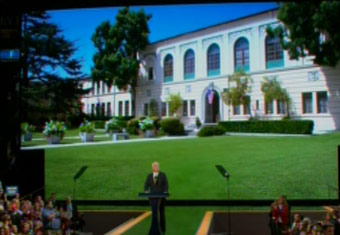
As a student of Sforzian backdrops, this scenario being discussed here is almost too… and yet…
Did the GOP really use:
– an image of the main building at Walter Reed
– only it’s not the Army’s Walter Reed Medical Center but
– Walter Reed Middle School in North Hollywood
– that looks like a giant Mediterranean-style mansion, perhaps the McCain’s place in Palm Beach?
– And which has a giant green lawn
– that ends up recreating the horrible green backdrop of McCain’s speech the night Obama took the nomination?
– and which has been used as a location for filming Malcolm in the Middle, Growing Pains, and Transformers?
It’s like the Sforzian equivalent of blinking out a secret message in Morse code: O-B-A-M-A.
related? A WSJ profile of McCain’s creative director and the guy responsible for “the planning of the program and the production of the videos shown [at the convention],” “Hollywood” Fred Davis [wsj.com]
That’s Not-Change I Can Believe In
“Just from what little I’ve seen of [Michelle] and Mr. Obama, Sen. Obama, they’re a member of an elitist-class individual that thinks that they’re uppity,” Westmoreland said. Asked to clarify that he used the word “uppity,” Westmoreland said, “Uppity, yeah.”
-Rep. Lynn Westmoreland, Republican congressman from Georgia’s 3rd District, as quoted in The Hill
You know, I was going to make a joke about how John McCain had said, “We’re all Georgians now,” but then I realized Westmoreland is the guy could only come up with three of the Ten Commandments on The Colbert Report. And I can’t top that.
This is the classic, Southern good old boy in the building industry racism that we have in North Carolina, too. Only stupider.
Sforzando

Laura Bush tells the audience at the GOP Convention that a new life awaits them in the off-world colonies. [image: Damon Winter/NYT. He’s got a great one of Fred Thompson, too]
Pro-Life, Except In The Case Of Decorating
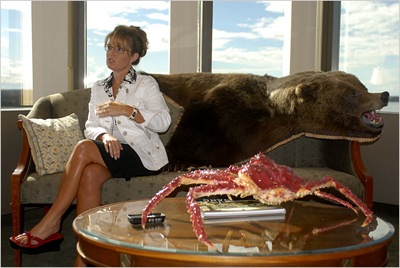
There’s no photo credit, but I’m assuming that Gawker scanned this image of Gov. Sarah Palin from an issue of Alaska Interiors. I hope McCain keeps her on for a while, this is awesome.
“Hi, Howya Doin’? Gustav? Is That Swedish?”
Don’t mind us, We just need to borrow The Big Board for a minute to take some pictures…
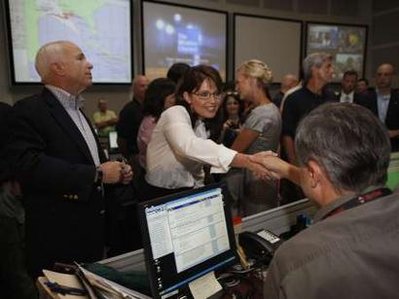
…and to see how Roddick’s doing. No, no, don’t let us bother you. You just keep looking like you’re working.”

From the Washington Post:
Even war has not disrupted political conventions in recent years, but the extraordinary decision to alter what had been a meticulously planned coronation reflected the powerful and lingering political impact of Katrina. Although convention officials refused to discuss any political links between the Bush administration’s response to Katrina and their current predicament, some Republicans here were clearly hopeful that by quickly shifting the theme of the convention to aiding relief efforts, they could buttress their efforts to show that a McCain administration would represent a departure from Bush. “It’s beginning to creep around the edges that this could be a plus,” said one GOP operative who listened in on a campaign conference call Sunday.
And by “this” he means, “using the destruction from a giant hurricane as the backdrop for McCain’s nomination speech.”
[images: reuters/john gress; afp/robyn beck via yahoo]
Don’t Go Chasing ‘Waterfalls’ Before Lunch
The water that falls half as long falls twice as bright.
If the best part of Olafur’s New York City Waterfalls is how their manmade nature is emphasized by their somewhat arbitrary schedule, well, they just got twice as arbitrary, and so twice as good.
The Public Arts Fund has announced a 50% cutback [from 101 hrs/wk to 50] and revised operating hours for the waterfalls after complaints that the salty mist is killing shrubs in Brooklyn.
Beginning Sept. 8th, the new hours are:
5:30 p.m. to 9 p.m. Mondays and Wednesdays
12:30 p.m. to 9 p.m. Tuesdays, Thursdays, Fridays, Saturdays and Sundays.
Please plan your dog walks accordingly.
Hours Are Cut for ‘Waterfalls’ [nyt/ap]
We’re All Americans Now

Arrivederci, Sforza.

